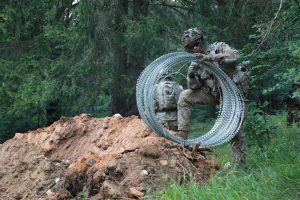So You’ve Received an Additional Duty

Congratulations; or I’m sorry that happened to you, whichever applies. Most likely it’s the latter. Since junior officers are already so busy with their immediate work, an additional responsibility—usually something obscure and far removed from an initial conception of their job—is the last thing that they want to deal with. If you’ve been appointed as an additional duty officer, usually via a memo from your commander, there’s no getting around it. So how do you succeed and make the most of it? As the former safety officer for my battalion, I have three suggestions: embrace the training, lean into the challenge, and build a legacy worth leaving behind.
Embrace the Training
If you’ve received an additional duty, you most likely need to complete some training associated with your new duty. Usually, this training is available online, and similar in format to the various 350-1 training with which you’re already familiar. Yes, you may have to find time during the duty day or immediately after work to knock it out. Yes, you may even have to go TDY to attend a weeklong course to get the necessary certifications. But yes, you do get an opportunity to take a break from your current responsibilities to learn something completely new. Personally, I enjoyed learning more about railhead operations in unit movement officer training than classes on mishaps in my safety officer courses. But, I did learn something. Moreover, I appreciated the opportunity to train for the sake of training after being several years removed from the schoolhouse. So try and do the same thing. Find a block of time to complete the certificates or prepare to travel to learn a new skill. When or where you will apply these skills, I can’t say. But in a world marked by ever more diverse challenges, who knows just when you will need these skills for the Army’s missions ahead.
Moreover, at a later point in your career, you are going to be in a position that requires you to oversee these same programs. So the more you know now, the less learning you have to do when you find yourself in a supervisory role. Embrace being prepared and embrace the training.
Lean Into the Challenge
Don’t be timid. When I was first appointed as my battalion’s safety officer, I was more than happy to lean on my BN S3’s tasking authority and company counterparts to get the required training done. And I was more than happy to leave it at that. As you can probably guess, that didn’t work. I hardly received any training certificates. I barely received an acknowledgment of the training to begin with. Frankly, I failed. But why? My energy level (low) reflected my level of commitment (low), and ultimately, my style of communication (weak) and mission success (or lack thereof). Fast forward a few weeks and a particularly contentious command and staff meeting, and I realized that I had much more work to do. I followed up with the individual companies, this time in person, to see what went wrong, I realized their hesitancy and lack of enthusiasm reflected my own. Some companies were confused about which Soldiers had to complete what training. Others weren’t even tracking this safety training was a requirement in the first place. Put bluntly, these companies, on the issue of safety training, reflected their leadership: me. If I wanted them to change, I had to change. But how?
Build a Legacy Worth Leaving Behind
BLUF, I got energized, and I got creative.
First, I created a tracker that listed every Soldier in my battalion and what training they needed to complete based on their age and rank. A new tracker breaking down which Soldiers needed what training not only flattened communications on just what was outstanding, it resolved confusion among the command teams and company safety officers. Additionally, I circled back to my post safety office for full-size safety posters for topical safety issues facing our unit. Finally, I posted a physical tracker of the roster I created on a display board so Soldiers walking by could inspect just what training they needed to complete.
With this investment of my time and energy came a similar investment from the companies and our Soldiers. Training certificates, questions, and general interest all flowed in from the companies like they never had before. The program wasn’t quite fixed (that would take much more work), but it was finally moving in the right direction. Sometimes that’s all it takes; forward momentum to turn something into a usable program, rather than a drain on organizational bandwidth at inopportune times.
Conclusion
Whether you’re an additional duty officer or not, you’re probably responsible for some process within your company or battalion. You’re probably, through no fault of your own, doing your job with due diligence, but not quite seeing the results you want to see. Your wheel—maintenance, logistics, training, or any duty under the sun—is just waiting to be reinvented or revamped to become something better. And that something better may not necessarily be a new tracker or improved board, but it is probably something that is waiting for you to lean into and build a legacy worth leaving behind. So, congratulations on the new role, and learn everything you can; it will pay dividends later!
1LT Clinton Grable is a Military Intelligence Officer stationed at Fort Gordon, GA with the 513th MI Brigade. A 2022 Leadership Fellow with the Center for Junior Officers, 1LT Grable was the previous safety officer for the 202nd MI Battalion.



